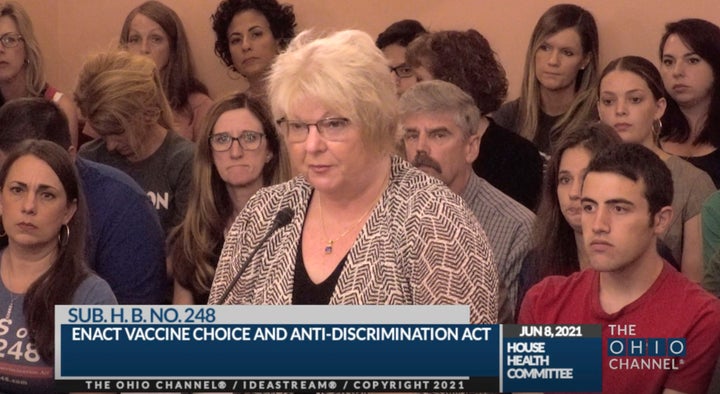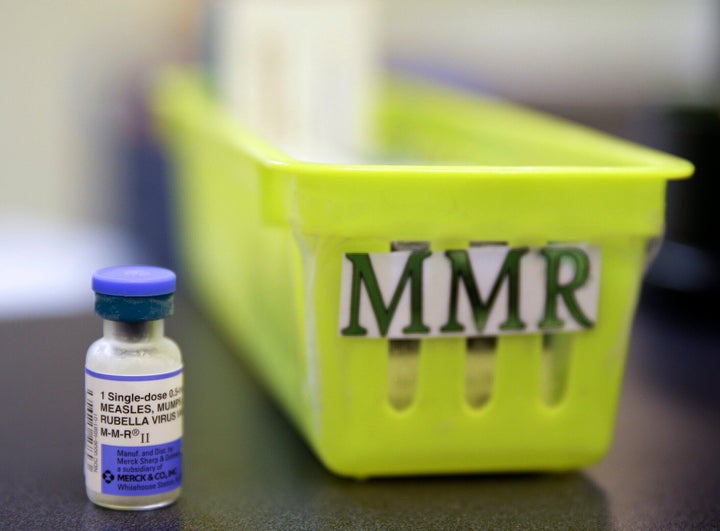A measles outbreak among dozens of unvaccinated children in Ohio has local health officials concerned about a deepening distrust of vaccines among some parents. With vaccination rates slipping around the country, more Americans are beginning to question the value of vaccine requirements for kids ― putting at risk a growing group of young children with no immunity to the virus.
Decades-old wariness of the measles vaccine ― based on well-funded false claims about a nonexistent link to autism ― has combined with the backlash against COVID vaccination rules and other pandemic-related hurdles to result in a slowdown in childhood vaccination rates.
Taken together, these factors increase the risk of outbreaks like the one in Ohio. There have been 82 diagnosed measles cases in the state, almost all in the Columbus area, and the vast majority in patients 5 years old or younger. Most of the cases have occurred in the past two months, leading to the hospitalization of 33 children, primarily for dehydration, diarrhea and pneumonia.
Seventy-five of the 82 kids were completely unvaccinated and four were partially vaccinated, having received one of two measles, mumps and rubella, or MMR, shots. Measles is remarkably contagious, infecting up to 90% of unimmunized people who come close to an infected person.
Nearly two dozen of the Ohio patients were too young to be protected. According to state data, there have been 23 measles cases among children younger than 1 year. Children typically receive their first measles shot when they’re between 12 and 16 months old. When measles came to town, those infants ― and other children too immunocompromised to handle certain vaccines ― had to rely on protection from their neighbors and classmates.
“When a parent makes a decision not to have their child vaccinated, they’re not realizing the implications of that decision. If their child can get that infection, it doesn’t just have an impact on their child or their household, but it can impact their school, it can impact their community,” Mysheika Roberts, who leads Columbus’s public health department, told HuffPost.
The Ohio outbreak is a case in point: Between June and October, the first four measles cases since 2019 emerged in the state, all of them among unvaccinated, unrelated people who’d traveled to a measles-endemic country and returned to the U.S. By early November, four cases in children with no travel history were linked to a local day care. By the end of that month, there were 46 confirmed cases, and the exposure sites had multiplied, too, including a mall, a church and a supermarket.
At this point, the total number of cases has stayed the same for several days. But holiday travel and measles’ long incubation period ― up to 21 days ― means the virus may well still be spreading undetected.
“We’ve got a ways to go,” Roberts said. “Anything could happen.”
The COVID Vaccine Dip
Measles was technically declared eliminated in the U.S. in 2000.
But outbreaks have popped up over the last two decades. The worst one hit hundreds of people in New York and New Jersey in 2019, just a few months before COVID-19 spread through the area. The measles outbreak occurred largely among the Orthodox Jewish community; other outbreaks have similarly occurred within close-knit communities, such as the Amish.
And nationwide, vaccine trends have taken a troubling turn since the COVID-19 pandemic began.
During the 2020-21 school year, the estimated rate of kindergarteners who met state-level vaccine requirements ― MMR, chicken pox and DTaP, the vaccine for diphtheria, tetanus and whooping cough ― fell by roughly a percentage point across the board, according to the Centers for Disease Control and Prevention. The percentage of kindergartners with two doses of the measles vaccine fell from 95.2% the year before to 93.9%.
But the top-line numbers belie the pockets of low coverage across the country. On top of the 2.2% of kindergartners nationwide who had at least one vaccination exemption ― 86% of which were classified as non-medical ― an additional 3.9% without an exemption weren’t up to date on their measles shots, according to the CDC data.
“This means there are 35,000 more children in the United States during this time period without documentation of complete vaccination against common diseases,” Georgina Peacock, the immunization services director at the CDC, said at a news briefing in April.
And that’s not counting an approximately 10% drop in kindergarten enrollment that year ― representing roughly 400,000 kids, including an unknown number who were behind on their vaccines.
Several things could factor into the nationwide dip in MMR vaccination rates. But it appears the backlash to COVID-19 public health measures ― particularly vaccine mandates ― played a significant role. As COVID vaccines arrived on the scene, so did fear-mongering: Social media and online forums were full of erroneous claims about the vaccines not being properly vetted and containing microchips that could track individuals. One Ohio doctor is currently under investigation by the state’s medical board after speculating that the vaccine had magnetized its recipients.

Polling by the Kaiser Family Foundation last month found that 26% of adults who have not gotten vaccinated against COVID-19 think the risks of the MMR vaccine outweigh the benefits. And while adults overall still overwhelmingly think the MMR vaccine’s benefits outweigh its risks (85% to 12%), a striking number have changed their minds about vaccine requirements in the past three years. Twenty-eight percent of adults agree with the sentiment “Parents should be able to decide not to vaccinate their children, even if that may create health risks for other children and adults,” up 12% from the findings of a 2019 Pew Research Center poll, Kaiser Family Foundation noted.
Stephanie Stock, president of the anti-vaccine-mandate group Ohio Advocates for Medical Freedom, told HuffPost in an email that various COVID-related claims by health authorities, such as changing guidance on masks, “certainly led people to question the level of trust to place in them.”
“Many Ohioans came to OAMF during the pandemic to find out what medical choice rights they have and how to become politically involved in fighting to protect those rights,” Stock said. Asked whether the anti-vaccine movement is responsible for an increased risk to kids who can’t get vaccinated because they are too young or immunocompromised, Stock wrote that her group “believes parents, not communities, are responsible for a child’s health, and that those parents are best suited to make the health decisions they feel are in the best interest of that child.”
It’s too early to say how much of an overlap there is between Americans who have hesitated to get vaccinated for COVID and those who have delayed or skipped their kids’ MMR shots. But according to Michael Osterholm, director of the Center for Infectious Disease Research and Policy, “there is this sense right now that much of the negative energy that has grown up around COVID vaccines is now spilling over substantially to childhood immunizations.”
“We’re seeing in more and more counties around the country lower levels of immunization for routine childhood vaccines that really parallels the same lack of support for COVID vaccines,” Osterholm told HuffPost.
“There is this sense right now that much of the negative energy that has grown up around COVID vaccines is now spilling over substantially to childhood immunizations.”
- Michael Osterholm, director of the Center for Infectious Disease Research and Policy
Ohio doesn’t require vaccination reporting statewide, so it’s difficult to know the state’s actual vaccination rates for measles or other viruses.
But Ohio schools do keep data on students’ required vaccinations. Data provided to HuffPost by the Ohio Department of Health show a noticeable drop in vaccination among kindergartners since the COVID pandemic began. From the 2019-2020 school year to the 2021-22 school year, the rate of kindergarten students up to date on their MMR, polio and DTaP vaccines fell from over 92% to under 89% for all three vaccines. Kindergarteners with up-to-date chickenpox vaccines fell from 91.9% to 87.8%. And hepatitis B vaccination rates fell from 94.9% to 92.7% over the same period.
“This [outbreak] is something that’s a direct consequence of being behind in vaccinations,” said Alexandria Jones, assistant health commissioner and director of prevention & wellness at Franklin County Public Health.
Much of measles vaccine hesitancy in the U.S. comes down to a single word: autism.
There is no evidence ― none ― of a link between the measles vaccine and autism spectrum disorder. But the myth has been around since Andrew Wakefield, a since-discredited British physician, claimed in a 1998 study that such a connection existed. That study was later retracted by The Lancet and the editor called statements in the paper “utterly false.” Several large studies around the world have refuted Wakefield’s claimed findings, and Wakefield was ultimately struck from the British medical register.
Nonetheless, concerns about vaccine-induced autism have persisted for decades, churning on social media and by word of mouth, and accelerated in the COVID era by the backlash against coronavirus vaccine mandates. Scott Jensen, the recently unsuccessful Republican candidate for governor in Minnesota, headlined an anti-vaccine-mandate rally in that state’s capitol building despite his state seeing a troubling 22 reported measles cases between June and November last year.
“When I was a child measles was a [rite] of passage, or childhood illness, as was chicken pox,” Scott Shoemaker, president of the anti-vaccine-mandate group Health Freedom Ohio, told HuffPost in an email, adding: “When the vaccine was released, it became a ‘deadly disease.’”
That’s false: Thousands of Civil War soldiers perished of measles, and in the first decade of nationwide tracking, in the early 20th century, there were 6,000 measles-related deaths per year on average, according to a CDC history. According to the same history, in the decade before the vaccine was introduced, an estimated 400 to 500 people died annually of the virus, on top of 1,000 estimated encephalitis cases and 48,000 hospitalizations.

‘He Just Made Up A Story’
In Minnesota, anti-vaccine groups, “skeptics” and others opposed to vaccine mandates for school children ― including Wakefield ― have made their presence known at community events for years. They played in particular to anxieties in the Somali community about autism. One University of Minnesota study found that 1 in 32 Somali children in Minneapolis had autism spectrum disorder ― comparable to the rate among white children, for whom the prevalence was 1 in 36, but more than Black and Hispanic children. (The study was small and had major limitations, its lead researcher said.)
“They are everywhere. Like, every event, every forum,” Fatuma Ishtar, a community outreach worker, told Stat News of anti-vaccine activists in 2017, as a measles outbreak swept through the community. “They continue to push the community. I feel offended by this group.”
That same year, as the outbreak was ongoing in Minnesota, Columbus public health officials held forums to answer questions about vaccines from Somali Ohioans. They discussed the University of Minnesota study and emphasized the lack of any evidence of a link between autism and vaccination.
Attendees’ concerns nonetheless echoed those of millions of Americans worried about their kids’ development: “A lot of people believe the vaccination ― the MMR ― is causing autism, because when we were back home, we never had autism. So why do we have now more than zero back home?” one man asked at a forum. At another event, an attendee noted that he was concerned for his young children: “Autism is a lifetime disease.”
The health officials were clear about the existing uncertainty surrounding autism spectrum disorder. But they also stressed the lack of any evidence tying it to vaccines.
“Let me clarify about the British doctor who started it all: He lied. He just made up a story, and so we cannot trust whatever he said, because it was proven, he lied,” Tatyana Karakay, a pediatrician at Nationwide Children’s Hospital, told community members at one forum. Studies of thousands of children, she said, had failed to find a connection between the vaccine and autism. “We don’t know what causes it, and it makes all of us worried, but we know what does not.”
“When autism was first discovered, the first theory was it was bad mothers who caused it,” Karakay added. “I’m sure all of you will agree that’s not true. So we know a lot of things that don’t cause it. MMR is one of them.”
The current Ohio outbreak is not contained to one particular community, both Jones and Roberts told HuffPost ― it’s a diverse group of patients united, primarily, by being unvaccinated. And on that front, there’s some good news: Vaccination sites run by both the city of Columbus and Franklin County saw noticeable increases in MMR vaccination visits last year.
But the troubling trends in the state and nationwide have health officials worried that parents are delaying vaccines. Given that signs of autism spectrum disorder may begin to appear in early childhood, some parents wait to have their kids take the MMR shots. Rather than following the advised schedule ― one shot each at 12-15 months and 4-6 years ― some parents wait for their kids’ first shot until it’s required for school.
That leaves infants and immunocompromised children vulnerable. And even if most kids can survive a case of measles with moderate symptoms, there’s no way to know who could have more severe consequences, including encephalitis or other severe effects.
“We don’t know who is going to get really, really sick,” Jones said. “I don’t want any parent to take that chance.”

